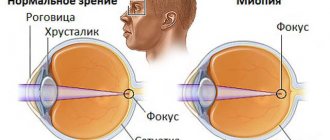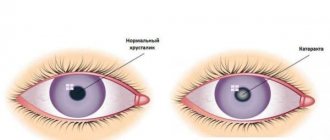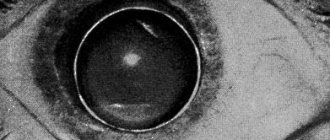A high degree of myopia, in other words, severe myopia, significantly harms a person’s quality of life, reducing opportunities at work and at home. He is unable to see objects located at a distance from him, but is able to see objects close to him.
The organ of vision in all people has almost the same parameters, differing only by fractions of millimeters. The degree of myopia depends mainly on the anterior-posterior size of the eye - the so-called internal axis. For nearsighted people it is too large. Because of this, the cornea of the eye is located at a great distance from the retina, located in the posterior regions. Rays of light, having passed through the cornea and refracted in the internal structures and media of the eye, do not fall on the retina, but are concentrated in front of it. In this case, the image takes on blurry shapes.
With severe myopia, it can be difficult to achieve normal vision with regular lenses or glasses. However, in recent years, science and medicine have achieved considerable results in the field of refractive surgery.
Nowadays, with the help of intraocular lenses (hereinafter referred to as IOLs), it is possible to correct vision of almost any severity. An alternative method of eye surgery has become the implantation of IOLs for high myopia (8 diopters and above).
Indications for surgery
If the function of the lens is excessively impaired, the doctor prescribes surgery. This is a rather radical measure, but after completing the procedure the person will be able to clearly see surrounding objects.
The operation is not always performed, but only for the following indications:
- high degree of myopia - over 15 diopters;
- violation of the refractive power of the lens, as a result of which the light beam is incorrectly projected on the retina;
- congenital or acquired abnormal lens structure;
- hereditary diseases, as a result of which the functioning of the lens is disrupted;
- accumulation of insoluble protein fractions, which forms clouding of the internal contents of the lens;
- inability to perform laser surgery due to contraindications or lack of effect;
- the patient’s desire to undergo the procedure so as not to wear glasses and contact lenses.
It is recommended to perform lens replacement operations after 25 years. As a person ages, their eyes stop growing, so the effect after the procedure lasts for a long time. Surgical interventions are prohibited for persons under 18 years of age.
Vision with astigmatism and myopia
Nearsightedness or myopia is a visual defect characterized by poor distance vision. With myopia, the refractive ability of the cornea is impaired due to an increase in the size of the eyeball. The rays of light form an image not on the retina itself, but directly in front of it, as a result of which objects that are far from it appear blurry to a person. With high myopia, it is difficult for the patient to see even the face of the interlocutor.
Astigmatism is an equally severe visual defect. It occurs due to the curvature of the eyeball, cornea or lens of the eye. Light rays fall on two points of the retina, which leads to blurriness of the resulting image. A person with astigmatism almost constantly squints to make the image clearer.
Operational process
An intraocular lens (IOL) is a device that replaces the natural human lens. It is made of biocompatible materials that do not cause a reaction from the immune system. That is, after the introduction of an IOL, rejection does not occur.
First, the doctor examines the person’s eyes and selects an IOL individually for his vision. The following factors are taken into account:
- patient's visual acuity;
- the material from which the lens is made (hardness, presence of filters);
- the patient's work, the frequency of gaze transfer from one point to another is taken into account.
The surgical intervention takes place in several stages:
- Patient preparation. A person should report to a clinical facility in the morning on an empty stomach. It is not recommended to use a sedative before surgery to avoid side effects during the procedure. The doctor may ask the patient to apply antibacterial drops into the eyes a few days before surgery to prevent the spread of infection.
- Instilling an anesthetic into the patient's eyes. General anesthesia is not used, since after it the person’s well-being worsens.
- An incision on the cornea, detachment of the flap.
- Dissolving a person's own lens using a laser device.
- Placing an intraocular lens inside the eyeball, securing the cornea to the surface of the eye.
We recommend reading: Lens replacement
Immediately after the operation, the patient must remain in the clinic for several hours. Doctors are monitoring his condition. If no complications arise after the procedure, the person is sent home. It is important that he is accompanied by people, since the first day there may be a slight decrease in visual acuity.
If complications arise, the patient is prescribed additional diagnostic tests. The doctor identifies the cause of the deviation and carries out procedures to eliminate it. If the patient's condition worsens sharply, he is hospitalized.
Lens replacement for high myopia reviews
We have all heard the concept of “myopia” or “myopia”. A person with this disease has difficulty seeing objects located at a great distance. This is where the name of the disease comes from - good vision is preserved only at arm's length. You need to start treating myopia as early as possible - then you can avoid many complications and you won’t have to resort to surgery. However, in some cases, conservative methods do not help and the doctor prescribes a lensectomy - a refractive lens replacement that can be used to restore normal vision to the patient.
Lens replacement for myopia is prescribed in the following cases:
- 1) High myopia – from -15 to -20 D
- 2) Refractive errors
- 3) Changing the shape of the lens
- 4) Hereditary lens diseases
- 5) Lens opacities
- 6) Contraindications to laser vision correction.
- 7) Patient's reluctance to wear glasses or contact lenses
Lens replacement for myopia is performed only on patients over 18 years of age.
Until this age, the eye continues to grow and its systems and tissues are in the process of formation. Also, surgery is not performed if vision is rapidly deteriorating - myopia must first be “stabilized”. Remember - surgery is a last resort method, it is prescribed only when other methods of combating the disease have not been effective. In the early stages, they try to correct vision with glasses, scleroplasty, and keratotomy.
Replacement of the lens of the eye for myopia is carried out using the phacoemulsification method, which practically does not cause complications.
The operation takes 15-30 minutes and is performed under a microscope on an outpatient basis.
Through an incision, ultrasound is used to emulsify the patient's lens and then remove it. In its place, an intraocular lens (an artificial lens) is implanted, which will subsequently be responsible for focusing the image on the retina. Sometimes it becomes necessary to install not one, but two lenses, which is also not a big problem. IOLs for myopia and other operations on the lens are selected individually, taking into account the patient’s vision characteristics. Only a doctor can do this.
Complications during surgical treatment of myopia (myopia) are associated primarily with the course of the underlying disease. The fact is that with myopia, the eyeball becomes enlarged, which affects all systems of the visual organ. There may be:
- 1) Dystrophic changes in the retina
- 2) Retinal tears due to thinning
- 3) Reducing the thickness of the outer shell of the eye (sclera)
- 4) Retinal detachment
That is why lens replacement for high myopia is prescribed only after a thorough examination and taking into account all possible consequences.
The optimal age for surgery is after 40 years.
By this time, the ability to accommodate is partially lost, and the first signs of cataracts may appear. After surgery, the patient needs to visit an ophthalmologist regularly to monitor his vision and detect complications at the earliest stage.
Replacing the lens for myopia is a fairly well-established operation. The postoperative period is usually well tolerated. The patient is discharged the next day after the follow-up examination, and vision is restored almost immediately. However, it is necessary to observe some precautions, which are mainly related to the need to protect the operated eye from damage. Recommended:
|
The cost of replacing a lens for myopia is determined mainly by the cost of an artificial lens. You can choose a monofocal lens - it is cheaper, but you will need glasses for correction, since you will only see well at a certain distance. If you give preference to a multifocal lens, then you will not need glasses - such an lens has several focusing points for different distances. The price also includes consumables. You can find out the exact cost in our price list in the section on cataract surgery - phacoemulsification.
It is safe to say that after replacing the lens, myopia completely disappears and the patient returns to normal vision. Only sometimes people who have undergone surgery complain of minor discomfort in the eyes - double vision of objects from some angles or cloudiness of objects at certain distances.
In general, only about 5% of patients note inconvenience or side effects that have appeared in reviews.
We also note that everyone’s body characteristics are different and this may affect the postoperative period. You can read reviews in the corresponding section of the site. The surgical procedure is the same as for the treatment of cataracts.
source
If a person's eyes are completely healthy, he is able to clearly see surrounding objects. Myopia is a condition in which a person sees well near, but poorly at a distance. This disease is caused by many factors, one of which is clouding of the lens and disruption of its structure.
To completely eliminate the cause, you must consult a doctor in a timely manner. He will order diagnostic tests and prescribe treatment.
If the function of the lens is excessively impaired, the doctor prescribes surgery. This is a rather radical measure, but after completing the procedure the person will be able to clearly see surrounding objects.
The operation is not always performed, but only for the following indications:
- high degree of myopia - over 15 diopters;
- violation of the refractive power of the lens, as a result of which the light beam is incorrectly projected on the retina;
- congenital or acquired abnormal lens structure;
- hereditary diseases, as a result of which the functioning of the lens is disrupted;
- accumulation of insoluble protein fractions, which forms clouding of the internal contents of the lens;
- inability to perform laser surgery due to contraindications or lack of effect;
- the patient’s desire to undergo the procedure so as not to wear glasses and contact lenses.
It is recommended to perform lens replacement operations after 25 years. As a person ages, their eyes stop growing, so the effect after the procedure lasts for a long time. Surgical interventions are prohibited for persons under 18 years of age.
An intraocular lens (IOL) is a device that replaces the natural human lens. It is made of biocompatible materials that do not cause a reaction from the immune system. That is, after the introduction of an IOL, rejection does not occur.
Non-surgical eye treatment in 1 month.
First, the doctor examines the person’s eyes and selects an IOL individually for his vision. The following factors are taken into account:
- patient's visual acuity;
- the material from which the lens is made (hardness, presence of filters);
- the patient's work, the frequency of gaze transfer from one point to another is taken into account.
The surgical intervention takes place in several stages:
- Patient preparation. A person should report to a clinical facility in the morning on an empty stomach. It is not recommended to use a sedative before surgery to avoid side effects during the procedure. The doctor may ask the patient to apply antibacterial drops into the eyes a few days before surgery to prevent the spread of infection.
- Instilling an anesthetic into the patient's eyes. General anesthesia is not used, since after it the person’s well-being worsens.
- An incision on the cornea, detachment of the flap.
- Dissolving a person's own lens using a laser device.
- Placing an intraocular lens inside the eyeball, securing the cornea to the surface of the eye.
Immediately after the operation, the patient must remain in the clinic for several hours. Doctors are monitoring his condition. If no complications arise after the procedure, the person is sent home. It is important that he is accompanied by people, since the first day there may be a slight decrease in visual acuity.
If complications arise, the patient is prescribed additional diagnostic tests. The doctor identifies the cause of the deviation and carries out procedures to eliminate it. If the patient's condition worsens sharply, he is hospitalized.
Immediately after the procedure, the person does not feel anything, as the anesthetic is in effect. In a few hours its effect will end. Then itching, pain, and burning in the eyes appear. This state stops by the end of the day.
After the operation, the body experienced stress. Therefore, a person can sleep for a long period of time. Upon awakening, severe redness of the cornea will be detected. This is due to the fact that the integrity of the tissues was compromised. The redness goes away after a few weeks.
Recovery of the body occurs quickly, since the integrity of the skin, blood vessels and nerve tissues has not been compromised. A few days after the operation the person feels well. For several weeks after the procedure, it is recommended to adhere to the following rules:
It is recommended to get plenty of rest and sleep so that the body recovers faster. It is advisable to stay in a dark room for the first time after the procedure so that the eyes are not exposed to additional irritating factors.
Some categories of patients experience complications immediately after surgery that the doctor should warn about:
- disturbance of nutrition through the vessels of the retina and optic nerve;
- if the retina has been thinned, a rupture is possible after surgery;
- reduction in corneal thickness due to tissue damage;
- gradual retinal detachment that develops over some time after the procedure.
To prevent the development of complications from surgery, the doctor performs many diagnostic tests. The condition of all tissue structures of the eyeball is revealed. If an initial deviation is noticed, the doctor will suggest other methods to eliminate the disease in order to exclude the possibility of complete loss of vision function.
The price of the procedure depends on the choice of clinical institution, the cost of doctor’s services, and the selection of a specific type of intraocular lens.
There are 2 types of IOLs:
- monofocal, during the implementation of which the patient will additionally need glasses or contact lenses to improve visual acuity;
- multifocal, with great clarity, so vision is restored for a long time 100% after surgery.
The cost of a multifocal lens is much more expensive, since it is made from expensive materials. The patient can choose monofocal lenses, which have a lower cost. Prices for each procedure, preliminary tests, intraocular lenses are included in the price list.
On average, the operation costs from 40 to 100 thousand. rubles
Vladimir: Several years ago I was diagnosed with lens opacity. I couldn't see well even with glasses. The doctor said that with the installation of an artificial lens, my vision would return. I had surgery, after which I felt some discomfort and pain for 3 hours. After the operation was completed, my vision returned completely. Now I see it like when I was young.
Olga: I developed cataracts quite a long time ago. At first I used drops that eliminate clouding of the lens. But lately they have stopped helping. The doctor prescribed surgery. To make it cheaper, I chose monofocal lenses. Now I wear glasses and with their help I see well. I no longer complain about my eyesight.
Poor vision significantly worsens the quality of life and makes it impossible to see the world as it is.
Not to mention the progression of pathologies and complete blindness.
MNTK "Eye Microsurgery" published an article on non-surgical restoration of vision up to 90%, this became possible thanks to.
source
Astigmatism and myopia are the most common vision pathologies. They affect the visual organs of people of all ages and greatly interfere with a person’s full life. These refractive errors are corrected with glasses and contact lenses, and they can only be cured through surgery. In what cases is a lens replacement procedure prescribed?
Nearsightedness or myopia is a visual defect characterized by poor distance vision. With myopia, the refractive ability of the cornea is impaired due to an increase in the size of the eyeball. The rays of light form an image not on the retina itself, but directly in front of it, as a result of which objects that are far from it appear blurry to a person. With high myopia, it is difficult for the patient to see even the face of the interlocutor.
Astigmatism is an equally severe visual defect. It occurs due to the curvature of the eyeball, cornea or lens of the eye. Light rays fall on two points of the retina, which leads to blurriness of the resulting image. A person with astigmatism almost constantly squints to make the image clearer.
Both types of ametropia greatly complicate a person’s life, impose certain restrictions on him in professional activities, and interfere with his ability to play sports. These pathologies constantly progress if left untreated. For initial and moderate degrees of myopia and astigmatism, the patient is prescribed to wear glasses or contact lenses. However, correction means are not means of treatment; they only correct a refractive error, that is, they allow a person to see well, despite the presence of visual pathology. Myopia and astigmatism can be treated with laser surgery or lens replacement surgery. The latter treatment method is usually used for high degrees of myopia and astigmatism.
Recovery after surgery
Immediately after the procedure, the person does not feel anything, as the anesthetic is in effect. In a few hours its effect will end. Then itching, pain, and burning in the eyes appear. This state stops by the end of the day.
After the operation, the body experienced stress. Therefore, a person can sleep for a long period of time. Upon awakening, severe redness of the cornea will be detected. This is due to the fact that the integrity of the tissues was compromised. The redness goes away after a few weeks.
Recovery of the body occurs quickly, since the integrity of the skin, blood vessels and nerve tissues has not been compromised. A few days after the operation the person feels well. For several weeks after the procedure, it is recommended to adhere to the following rules:
- no makeup on the eyes;
- You cannot watch TV, work with a computer, phone, or tablet.
It is recommended to get plenty of rest and sleep so that the body recovers faster. It is advisable to stay in a dark room for the first time after the procedure so that the eyes are not exposed to additional irritating factors.
Complications after replacing the lens of the eye for cataracts
An effective and gentle method of phacoemulsification does not eliminate the risk of complications after replacing the eye lens for cataracts.
The advanced age of patients, concomitant diseases, and violation of sterility requirements by medical staff provoke undesirable consequences of the operation. Complications after cataract surgery occur in the form of swelling, astigmatism and other physical abnormalities.
People who have encountered such an unpleasant eye disease know firsthand that surgical intervention often ends badly, and there are complications after surgery.
Eye cataracts still require treatment. And unfortunately, the only way to get rid of the pathology is to perform an operation to remove the lens and replace it with an artificial one.
The procedure itself does not take much time and does not pose any threat to life and health, however, to avoid complications, you must adhere to certain rules and recommendations.
Types of complications
Complications that arise after the procedure include the following: Intraocular pressure in the eye increases. Inflammatory process. The retina of the eye peels off. Hemorrhage occurs in the anterior chamber.
The development of a disease such as secondary cataract. The new lens shifts slightly to the side. Below we will look at each type of complication in more detail. Inflammatory process.
After two to three days, all symptoms of inflammation should subside. Hemorrhage. This complication is rare; in most cases, it is associated with damage to the membrane or cornea of the eye at the time of surgery.
As a rule, the patient does not hurt anything, he sees everything, and after a few days there will be no trace of blood left, it will simply resolve. If this does not happen, the doctor will have to forcefully flush the anterior chamber.
Additional fixation of the lens is also performed. Intraocular pressure increases. This type of complication can occur because the drainage system becomes clogged with drugs of a viscous consistency.
The doctor uses them to protect the cornea of the eyes. You can solve the problem by dropping drops into the eye. In rare cases, the specialist makes a small puncture through which the eyes are subsequently washed. Swelling of the eye or cornea and astigmatism are also observed, but it goes away quickly.
Retinal disinsertion. This complication can be considered one of the most severe; it occurs due to injury during lens replacement. People who develop astigmatism also experience this complication.
Many ophthalmologists insist on performing an operation during which the sclera is sealed. If the area of detachment is insignificant, then restrictive laser coagulation can be performed.
Retinal detachment In addition, due to the fact that the retina detaches, another unpleasant problem arises - the lens moves. Patients complain of astigmatism, the eye hurts greatly, is constantly accompanied by a feeling of discomfort, and swelling occurs.
All symptoms last only for a while; after rest, this condition goes away. But with a significant displacement, visual discomfort will occur constantly. In order to solve the problem, it is necessary to perform repeated surgery.
The lens is completely displaced. Lens displacement is a dangerous and serious complication that requires immediate intervention from specialists. During the operation, the lens is lifted and then securely fixed in its new position.
Complications
Some categories of patients experience complications immediately after surgery that the doctor should warn about:
- disturbance of nutrition through the vessels of the retina and optic nerve;
- if the retina has been thinned, a rupture is possible after surgery;
- reduction in corneal thickness due to tissue damage;
- gradual retinal detachment that develops over some time after the procedure.
To prevent the development of complications from surgery, the doctor performs many diagnostic tests. The condition of all tissue structures of the eyeball is revealed. If an initial deviation is noticed, the doctor will suggest other methods to eliminate the disease in order to exclude the possibility of complete loss of vision function.
Vision with astigmatism and myopia
Nearsightedness or myopia is a visual defect characterized by poor distance vision. With myopia, the refractive ability of the cornea is impaired due to an increase in the size of the eyeball. The rays of light form an image not on the retina itself, but directly in front of it, as a result of which objects that are far from it appear blurry to a person. With high myopia, it is difficult for the patient to see even the face of the interlocutor.
Astigmatism is an equally severe visual defect. It occurs due to the curvature of the eyeball, cornea or lens of the eye. Light rays fall on two points of the retina, which leads to blurriness of the resulting image. A person with astigmatism almost constantly squints to make the image clearer.
Price
The price of the procedure depends on the choice of clinical institution, the cost of doctor’s services, and the selection of a specific type of intraocular lens.
There are 2 types of IOLs:
- monofocal, when introduced, the patient will additionally need glasses or contact lenses to improve visual acuity;
- multifocal, with great clarity, so vision is restored for a long time 100% after surgery.
The cost of a multifocal lens is much more expensive, since it is made from expensive materials. The patient can choose monofocal lenses, which have a lower cost. Prices for each procedure, preliminary tests, intraocular lenses are included in the price list.
On average, the operation costs from 40 to 100 thousand. rubles
What is long-term investing
What is the difference between a trader and a long-term investor
A trader tries to benefit from price fluctuations over short periods of time. Therefore, speculators often take advantage of local events on the Russian market or expectations from them.
The investor is trying to make money on fundamental principles and large-scale changes in the companies' business.
For ease of perception, I will transfer some differences to the table.
Trader Investor Short-term trading Investing for the long term Making quick decisions to buy and sell shares based on a single factor or local event Analyzing the entire issuer, making careful trade decisions Using technical indicators or specific financial triggers Focusing on the operating performance of the business or global changes in the company Establishing time or risk restrictions on a position Exiting a position in accordance with the achievement of the goals of a long-term idea or due to its cancellation Counting on small but frequent profits Counting on a large increase in the value of shares and receiving dividends Operating with small capital in transactions Large investments and creating diversified portfolios
Why long-term investing is sometimes combined with trading
Different ideas may translate differently into the nature of investing. The Russian market is influenced by many factors, and trading participants are not always able to predict and control risks. Therefore, investors are looking to diversify their approaches. This is called diversification of strategy.
As an example, I will immediately move on to the Russian stock market.
The geopolitical situation around our country has been in a tense state for a long time. The stock prices of our companies are affected by sanctions pressure and associated risks. Therefore, securities of Russian issuers maintain a significant discount to their global counterparts over a long period.
Why long-term investments are not popular in Russia
Recently, the situation with long-term investing has been changing for the better. Products have appeared in the form of individual investment accounts, which have gained well-deserved popularity, and more and more participants in the Russian market prefer investing.
Some people, influenced by advertising, choose exclusively speculative strategies in the hope of getting rich quickly. Subsequently, such people, having lost money, switch to more conservative and long-term approaches using fundamental analysis of company shares.
As for investing on the stock exchange in general, the matter here is complicated by the Russian mentality and historical aspects. Shares are vested rights to own part of a company's business. And when in our country the rights of citizens are violated with enviable regularity, people are reluctant to give their money to the stock market.
How much can you earn
The main benchmark for determining profitability on the Russian market is the Moscow Exchange index. Dividends should also be taken into account. Over the past 10 years, the Moscow Exchange index with total return (MICEX Total Return) brought about 13% per annum.
If we talk about real numbers, then a more or less diversified portfolio with separately selected promising shares of companies can on average bring 15-35% per annum, taking into account dividends.
Patient reviews
Vladimir: Several years ago I was diagnosed with lens opacity. I couldn't see well even with glasses. The doctor said that with the installation of an artificial lens, my vision would return. I had surgery, after which I felt some discomfort and pain for 3 hours. After the operation was completed, my vision returned completely. Now I see it like when I was young.
Olga: I developed cataracts quite a long time ago. At first I used drops that eliminate clouding of the lens. But lately they have stopped helping. The doctor prescribed surgery. To make it cheaper, I chose monofocal lenses. Now I wear glasses and with their help I see well. I no longer complain about my eyesight.











